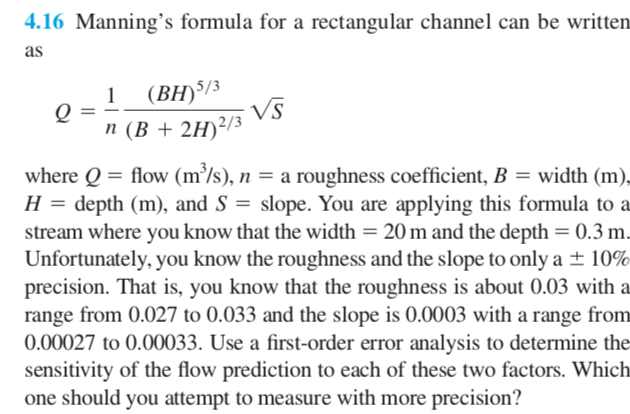Question
MATLAB code please! use 5% precision not 10%. Mannings formula for a rectangular channel can be written as Mannings formula for a rectangular channel can
MATLAB code please!
use 5% precision not 10%.

Mannings formula for a rectangular channel can be written as
Mannings formula for a rectangular channel can be written as
Q=(1)(BH)^5/3/(B+2H)^2/3 *(sqrt(S))
where Q 5 flow (m3/s), n 5 a roughness coefficient, B 5 width (m), H 5 depth (m), and S 5 slope. You are applying this formula to a stream where you know that the width 5 20 m and the depth 5 0.3 m. Unfortunately, you know the roughness and the slope to only a 6 10% precision. That is, you know that the roughness is about 0.03 with a range from 0.027 to 0.033 and the slope is 0.0003 with a range from 0.00027 to 0.00033. Use a first-order error analysis to determine the sensitivity of the flow prediction to each of these two factors. Which one should you attempt to measure with more precision?
where Q = flow (m3/s), n = a roughness coefficient, B =width (m), H = depth (m), and S = slope. You are applying this formula to a stream where you know that the width = 20 m and the depth = 0.3 m. Unfortunately, you know the roughness and the slope to only a 5% precision. That is, you know that the roughness is about 0.03 with a range from 0.027 to 0.033 and the slope is 0.0003 with a range from 0.00027 to 0.00033. Use a first-order error analysis to determine the sensitivity of the flow prediction to each of these two factors. Which one should you attempt to measure with more precision?
4.16 Manning's formula for a rectangular channel can be written as Q=1 (BH)5/3 n (B + 2H) 2/3 VS where Q = flow (m/s), n = a roughness coefficient, B = width (m), H = depth (m), and S = slope. You are applying this formula to a stream where you know that the width = 20 m and the depth = 0.3 m. Unfortunately, you know the roughness and the slope to only a + 10% precision. That is, you know that the roughness is about 0.03 with a range from 0.027 to 0.033 and the slope is 0.0003 with a range from 0.00027 to 0.00033. Use a first-order error analysis to determine the sensitivity of the flow prediction to each of these two factors. Which one should you attempt to measure with more precision? 4.16 Manning's formula for a rectangular channel can be written as Q=1 (BH)5/3 n (B + 2H) 2/3 VS where Q = flow (m/s), n = a roughness coefficient, B = width (m), H = depth (m), and S = slope. You are applying this formula to a stream where you know that the width = 20 m and the depth = 0.3 m. Unfortunately, you know the roughness and the slope to only a + 10% precision. That is, you know that the roughness is about 0.03 with a range from 0.027 to 0.033 and the slope is 0.0003 with a range from 0.00027 to 0.00033. Use a first-order error analysis to determine the sensitivity of the flow prediction to each of these two factors. Which one should you attempt to measure with more precisionStep by Step Solution
There are 3 Steps involved in it
Step: 1

Get Instant Access to Expert-Tailored Solutions
See step-by-step solutions with expert insights and AI powered tools for academic success
Step: 2

Step: 3

Ace Your Homework with AI
Get the answers you need in no time with our AI-driven, step-by-step assistance
Get Started


